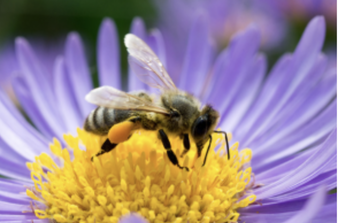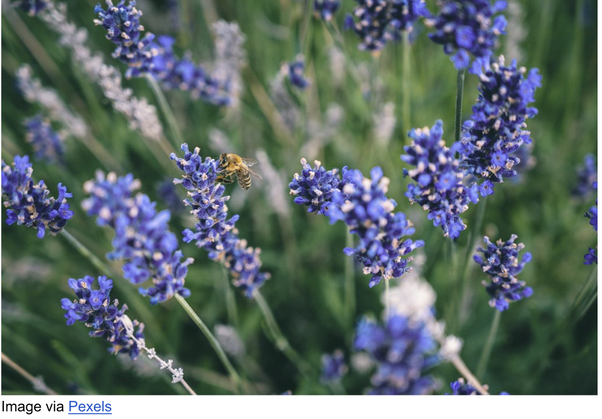
What Everyone Can Do to Help Bees!
1. Plant pollinator friendly plants! Flowers with pollen and nectar = food for bees. One of the biggest threats to pollinators is loss of habitat. Even small patches of flowering plants spread throughout both rural and urban areas can significantly help bees, and all pollinators.
Examples include:
Early Spring: Crocus
Mid Spring: Oregano
Late Spring: Borage, Rosemary, Thyme, Sage, Poppy
Summer: Lavender, Bee Balm, Coreopsis
Early Fall: Aster, Cosmos, Sunflower, Raspberry, Goldenrod
More info here (adapted from the Urban Bee Project): https://www.skynursery.com/wp content/themes/skynursery/docs/bee_friendly_plants.pdf
2. Build homes for native bees (like a mason bee house). Leave portions of your yard or garden uncultivated (leaving twigs, brush, and branches in place), allowing space for solitary bees to burrow.
3. Don’t use pesticides, and choose foods that are grown without the use of pesticides. Vote with your dollar! Pesticides are not only toxic to bees, but are harmful to humans too.
4. Create a water source for pollinators – shallow sources of water (like bird baths) work great!
5. Encourage others to plant bee friendly plants, and avoid pesticides. Support people and programs advocating for a healthy ecology.
1. Plant pollinator friendly plants! Flowers with pollen and nectar = food for bees. One of the biggest threats to pollinators is loss of habitat. Even small patches of flowering plants spread throughout both rural and urban areas can significantly help bees, and all pollinators.
Examples include:
Early Spring: Crocus
Mid Spring: Oregano
Late Spring: Borage, Rosemary, Thyme, Sage, Poppy
Summer: Lavender, Bee Balm, Coreopsis
Early Fall: Aster, Cosmos, Sunflower, Raspberry, Goldenrod
More info here (adapted from the Urban Bee Project): https://www.skynursery.com/wp content/themes/skynursery/docs/bee_friendly_plants.pdf
2. Build homes for native bees (like a mason bee house). Leave portions of your yard or garden uncultivated (leaving twigs, brush, and branches in place), allowing space for solitary bees to burrow.
3. Don’t use pesticides, and choose foods that are grown without the use of pesticides. Vote with your dollar! Pesticides are not only toxic to bees, but are harmful to humans too.
4. Create a water source for pollinators – shallow sources of water (like bird baths) work great!
5. Encourage others to plant bee friendly plants, and avoid pesticides. Support people and programs advocating for a healthy ecology.
| what_everyone_can_do_to_help_bees.pdf | |
| File Size: | 132 kb |
| File Type: | |
How to Create a Gorgeous Garden: A Beginner's Guide
Gardening is a fun hobby, offering the opportunity to enjoy a relaxing activity in the fresh air. Plus, a beautiful garden can ramp up curb appeal—which, according to RedFin, can boost home value. If you're new to gardening, you may not be confident in your ability to create a lush oasis. Don't stress. This resource guide covers the essentials you need to get started.
Start by creating a lush lawn
Your lawn takes up the most surface area in the garden and is the logical starting point.
Focus on flowers, bushes, and trees next
Prepare your plot of land to create a healthy space for strong growth.
Set your garden up for long-term success
If you want your garden to continue to thrive, you have to give it the right tools
If you've always dreamed of having a pretty garden, these tips can help you realize your vision. You don't have to spend big bucks on fancy landscapers. Most of these tasks are DIY, giving you the opportunity to put your green thumb to the test while enjoying time outdoors.
Gardening is a fun hobby, offering the opportunity to enjoy a relaxing activity in the fresh air. Plus, a beautiful garden can ramp up curb appeal—which, according to RedFin, can boost home value. If you're new to gardening, you may not be confident in your ability to create a lush oasis. Don't stress. This resource guide covers the essentials you need to get started.
Start by creating a lush lawn
Your lawn takes up the most surface area in the garden and is the logical starting point.
- Start by addressing bare patches in your lawn with reseeding, ideally in the late fall.
- Do an at-home soil test to determine what nutrients your lawn may be missing. You will then know what kind of fertilizer your grass needs.
- Search "best lawn fertilizer service near me" on Angi. Before meeting with a provider, request a quote and read reviews online. Prioritize those that use organic products.
Focus on flowers, bushes, and trees next
Prepare your plot of land to create a healthy space for strong growth.
- Select the appropriate site for your purposes. For instance, if you want to plant a vegetable garden, you need a spot that gets enough sun.
- Before planting, aerate the soil to alleviate compaction. This makes it easier for oxygen, water, and nutrients to reach the underlying roots.
- Select plants for your garden according to your climate zone.
- Lay out your garden in a way to optimize growth. For example, if your yard is sloped, plant your garden across the hill, not downhill.
Set your garden up for long-term success
If you want your garden to continue to thrive, you have to give it the right tools
- Create a pollinator-friendly space—for example, by planting flowers. West Seattle Bee Garden provides educational resources on how to accommodate bees.
- Incorporate other beneficial insects into your garden like ladybugs and praying mantises, which eat harmful pests.
- Implement an irrigation system, so your garden gets the regular watering it needs.
- When the weather cools down, add mulch around the bases of bushes and trees to protect against the cold.
If you've always dreamed of having a pretty garden, these tips can help you realize your vision. You don't have to spend big bucks on fancy landscapers. Most of these tasks are DIY, giving you the opportunity to put your green thumb to the test while enjoying time outdoors.
| how_to_create_a_gorgeous_garden__a_beginners_guide.docx.pdf | |
| File Size: | 197 kb |
| File Type: | |

